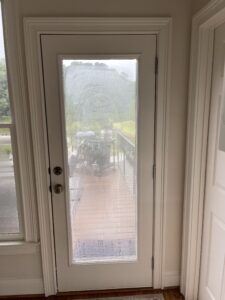Don’t Sweat the Dripping Windows
Understanding Condensation After an Atlanta Area Storm

A few days ago, Atlantans enjoyed a refreshing and long-awaited-for summer thunderstorm. The rain was needed after our long drought, but some homeowners were surprised to find their windows dotted with droplets of condensation on the outside. Fear not! It’s a perfectly normal response to a given atmospheric condition—like after a sudden storm.
Let’s understand why this happens.
Condensation occurs when warm, moist air comes into contact with a cooler surface. Think of a cold glass of ice water on a hot day – the water vapor in the air condenses on the colder glass, forming those familiar droplets. Similarly, after a hot, dry period, the sudden influx of cool, moist air from a thunderstorm can cause condensation on the exterior of your windows.
Here in Atlanta, the dew point – the temperature at which condensation occurs – plays a crucial role. After the storm, the dew point likely dipped below the surface temperature of your windows, triggering condensation droplets.
Why Would High-Quality Windows Show More Condensation?
Interestingly, some homeowners with high-efficiency Low-E windows (with a special coating that reflects heat) might even see more condensation compared to older windows. Low-E windows do an excellent job of keeping the cool air inside during the summer, while also insulating your home against heat gain from the outside.
Should I Be Worried About Condensation on My Windows?
In most cases, the answer is no. Condensation on the outside of your windows is a temporary phenomenon and doesn’t pose any threat. Once the outside air temperature rises above the dew point, the condensation will naturally disappear.Here are some additional points to consider:
- Airflow Considerations: If you notice excessive or persistent condensation, check to see if your air conditioning system is blowing directly on your windows. Vents positioned near windows can further cool the glass surface, and cause condensation. Adjusting the airflow direction might help minimize this.
- Double-Paned Windows: While condensation on double-paned windows is less common, if you see condensation between the panes, it might indicate that the window might have a broken seal. This will allow moisture to enter the space between the panes. This is a problem that requires professional attention to replace the seal and maintain the window’s excellent insulating properties.
Atlantans are accustomed to hot and humid summers. So, the occasional condensation on your windows after a storm is simply a sign of the changing weather patterns and shouldn’t be a cause for concern. However, if you notice persistent condensation or have concerns about your windows, consulting a professional is always recommended.

